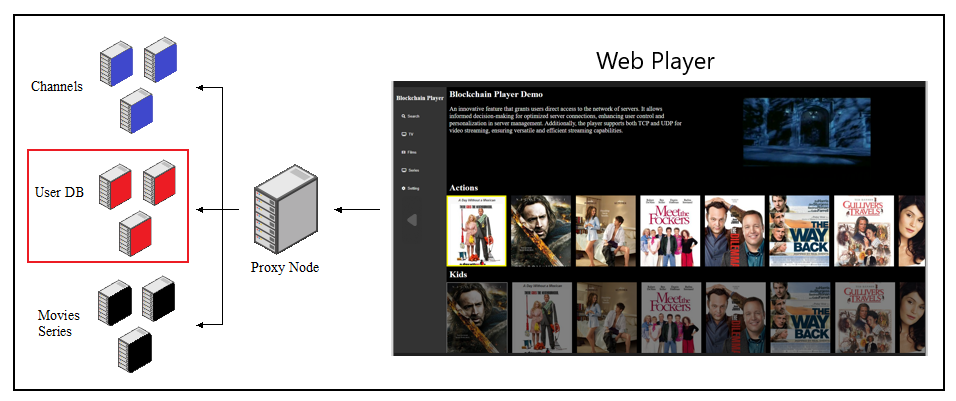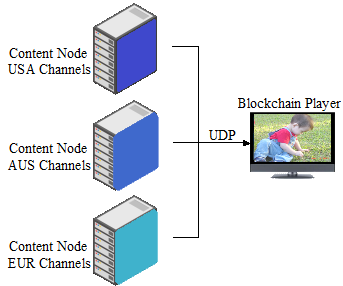Ezserver
Dynamic Streaming Protocol (DSP)
Cutting-edge video streaming solution that intelligently adapts to changing network conditions and server capacities. It combines IPTV TCP streaming and P2P UDP streaming over Web 3.0 blockchain technology, dynamically transitioning between them based on real-time demands. DSP reduces load balancer usage, optimizes content delivery, and adapts to network conditions, ensuring smooth streaming, efficiency, and cost savings.
As connection numbers approach the server's maximum capacity, the protocol seamlessly switches to P2P mode, optimizing content distribution and reducing server load. This adaptive approach ensures smooth, reliable video delivery, significantly minimizing buffering and latency issues. With the "Dynamic Streaming Protocol," video streaming providers can offer a cost-effective, efficient, and future-proof streaming experience to their audiences, revolutionizing the way content is delivered in the digital age.
Web 3.0 Blockchhain Nodes
The blockchain network consists of 4 pivotal nodes, each playing a crucial role in ensuring a robust and secure ecosystem for content delivery. These nodes are User Server, Content Server, Proxy Server and Reverse Proxy Server.
A Proxy Node acts VPN server to hide the User and Content Servers, or A Reverse Proxy Node hides the User Server, guarding it from direct exposure. This enhances security, load balancing, and overall performance.
Dynamic Streaming Protocol
Dynblends Web 3.0, blockchain, and P2P technology to ensure seamless content delivery. By dynamically transitioning between TCP and P2P UDP streaming, it optimizes distribution, redefining efficient streaming.
Low Latency Streaming
DSP employs UDP for "Low Latency Streaming." UDP's streamlined data transmission, though less error-resistant than TCP, accelerates content delivery, benefiting real-time applications by minimizing delays.
Secure Your Channels
By employing UDP (User Datagram Protocol) instead of TCP, a proactive defense strategy against unauthorized restreaming is implemented. UDP's rapid transmission discourages hackers, as it prioritizes speed over error correction, making channel restreaming more challenging due to the unpredictable data reconstruction process. While not ensuring complete data integrity, this approach enhances security by prioritizing low latency and content obscurity.
DSP employs advanced technologies like UDP streaming to minimize latency, ensuring that content reaches viewers with minimal delay. This benefit is especially critical for real-time applications like live streaming, online gaming, and video conferencing.
High Quality and Reliability
By dynamically adapting to changing network conditions, DSP maintains a consistent stream quality, even in less-than-ideal network environments. This translates to smoother playback, fewer buffering issues, and a more reliable viewing experience.
Efficient Bandwidth Usage
DSP optimizes bandwidth usage by intelligently switching between streaming modes, such as traditional unicast TCP and P2P-based UDP. This reduces the load on servers and lowers data transmission costs.
The protocol is designed to scale efficiently, accommodating a growing user base without compromising performance. It can dynamically allocate resources and adjust streaming methods to handle increased demand.
Improved Content Delivery
DSP ensures efficient and secure content delivery by minimizing bottlenecks, optimizing server resources, and reducing the risk of unauthorized content access.
By incorporating blockchain technology, DSP adds an extra layer of security to content distribution. It can verify the authenticity of content and prevent unauthorized access or tampering.
DSP intelligently balances incoming traffic across multiple servers, preventing overload on any single server. This load balancing improves server performance and uptime.
DSP supports adaptive streaming, allowing viewers to receive the best quality stream based on their device capabilities and network conditions. This adaptive approach optimizes the viewing experience.
The protocol offers robust content protection mechanisms, safeguarding against piracy and ensuring that content is only accessible to authorized users.
Lower latency and higher quality streams lead to improved user engagement. Viewers are more likely to stay engaged with content that loads quickly and plays smoothly.
By reducing server load and optimizing bandwidth usage, DSP can lead to cost savings for content providers, making it an economical choice for delivering content at scale.
DSP is designed to adapt to evolving technologies and user demands, making it a forward-looking solution for content delivery in an ever-changing digital landscape.
Server Software Specification
Windows
All Windows 64bits version
Linux
Ubuntu, Debian, CentOS
Streaming Type
Live, Delay,Catch-up
Input Protocol
HTTP / HLS / HTTPS
Output Protocol
P2P over UDP, Multicast over UDP
Video/Audio Format
MPEG TS, MPEG 4/H264, H265, ADTS, AAC, MP3
Source Link Backup
2 Backup URLs
Video/Audio Format
MPEG4, AAC, MP3, MKV
Input Protocol
Local Films, HTTP / HTTPS
Output Protocol
HTTP / HTTPS
Video/Audio Format
MPEG4, AAC, MP3, MKV
Input Protocol
Local Episodes, HTTP / HTTPS
Output Protocol
HTTP / HTTPS
Minimum Server Requirement
STB, Mobile Phone, Android Smarter TV
STB (recommended)



